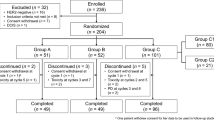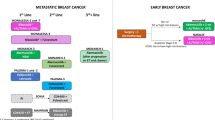Abstract
In this study we examined the clinical characteristics of relapse before and after complete clinical response (CR) to anthracycline‐based combination chemotherapy in metastatic breast cancer (MBC). Our goal was to determine whether similar clinical trends could be observed during first relapse and relapse after CR. Two hundred and sixty‐three patients with MBC were identified who had achieved CR after anthracycline‐based combination chemotherapy for first recurrence. From this group, 226 patients had relapse after CR after a minimum follow‐up of 13 years. Clinical features of their disease at first relapse and after progression from CR (second relapse) were examined, including disease‐free interval (DFI) from diagnosis until first relapse, sites of recurrence, response to subsequent therapy, and survival after progression from CR. There was a significant correlation between duration of CR and survival after progression from CR. Patients who relapsed <12 months after achieving CR had a median survival of 8.8 months after second relapse, whereas those who relapsed beyond 3 years had a median survival of 21.5 months (p = 0.0034). Neither the duration of CR nor length of survival after second relapse was related to the length of initial DFI. Patients with a short duration of CR (<12 months) more often experienced second recurrences at multiple sites and in visceral organs (62% and 75%, respectively) than did patients with prolonged CR (>36 months) (27% and 45%, respectively, p < 0.001). The anatomic location of metastatic disease at the time of first and second relapses was similar within a CR duration group but different among the groups. Short CR duration was associated with more frequent recurrence at visceral sites and also with chemotherapy‐resistant second relapse. In conclusion, prolonged CR is associated with long survival after second relaps; however, neither CR duration nor survival after second relapse is related to the length of initial DFI. This suggests that chemotherapy, when it induces CR, may change the pace of disease progression. The tissue pattern of recurrence appears to be similar between first and second relapse, suggesting that the cellular predilection for metastatic sites has been preserved.
Similar content being viewed by others
References
Hortobagyi GN: Multidisciplinary management of advanced primary and metastatic breast cancer. Cancer 74: 416–423, 1994
Greenberg PAC, Hortobagyi GN, Smith TL, et al. Long term follow-up of patients with complete remission following combination chemotherapy for metastatic breast cancer. J Clin Oncol 14: 2197–2205, 1996
Goldie JH: Drug resistance. In: Perry MC (ed) The Chemotherapy Source Book. Williams & Wilkins, Baltimore, 1996, pp 63–69
Morrow CS, Cowan K: Drug resistance and its clinical circumvention. In: Holland JF, Bast RC, Morton DL, et al.: (eds) Cancer Medicine. Williams & Wilkins, Baltimore, 1997, pp 799–815
Kuukasjarvi T, Karhu R, Tanner M, et al.: Genetic heterogeneity and clonal evolution underlying development of asynchronous metastasis in human breast cancer. Cancer Res 57: 1597–1604, 1998
Pusztai L, Hortobagyi GN: High dose chemotherapy: How resistant is breast cancer? Drug Resist Updates 1: 62–72, 1998
Hayward JL, Carbone PP, Heuson JC, et al.: Assessment of response to therapy in advanced breast cancer. Cancer 39: 1289–1294, 1977
Demicheli R, Abbattista A, Miceli R, et al.: Time distribution of the recurrence risk for breast cancer patients undergoing mastectomy: Further support about the concept of tumor dormancy. Breast Cancer Res Treat 41: 177–185, 1996
Retsky MW, Demicheli R, Swartzendruber DE, et al.: Computer simulation of a breast cancer metastasis model. Breast Cancer Res Treat 42: 193–202, 1997
Bloom HJG, Richardson WW, Harries EJ, et al.: Natural history of untreated breast cancer (1805–1933): Comparison of untreated and treated cases according to histological grade of malignancy. Br J Med 28: 213–221, 1962
Henderson IC, Canellos GP: Cancer of the breast: The past decade. N Engl J Med 302: 17–30, 1980
Tormey DC, Gelman R, Band PR, et al.: Comparison of induction chemotherapies for metastatic breast cancer. Cancer 50: 1235–1244, 1982
Falkson G, Gelman RS, Pandya KJ, et al.: Eastern Cooperative Oncology Group randomized trials of observation versus maintenance therapy for patients with metastatic breast cancer in complete remission following induction treatment. J Clin Oncol 16: 1669–1676, 1998
Ayash LJ, Wheeler C, Fairclough D, et al.: Prognostic factors for prolonged progression-free survival with high-dose chemotherapy with autologous stem-cell support for advanced breast cancer. J Clin Oncol 13: 2043–2049, 1995
Tomiak E, Piccart M, Mignolet F, et al.: Characterization of complete responders to combination chemotherapy for advanced breast cancer: A retrospective EORTC breast group study. Eur J Cancer 32A: 1876–1887, 1996
Fischer J, Rose CJ, Rubens RD: Duration of complete response to chemotherapy in advanced breast cancer. Eur J Cancer Clin Oncol 18: 747–757, 1982
Legha SS, Buzdar A, Smith TL, et al.: Complete remission in metastatic breast cancer treated with combination drug therapy. Ann Int Med 91: 847–852, 1979
Hietanen P, Miettanen M, Makinen J: Survival after first recurrence in breast cancer. Eur J Cancer Clin Oncol 22: 913–919, 1986
Goldhirsch A, Gelber RD, Castiglione M, et al.: Relapse of breast cancer after adjuvant treatment in premenopausal and perimenopausal women: Patterns and prognosis. J Clin Oncol 6: 89–97, 1988
Hortobagyi GN, Smith TL, Legha SS, et al.: Multivariate analysis of prognostic factors in metastatic breast cancer. J Clin Oncol 1: 776–786, 1983
Clark GM, Sledge GW, Osborne CK, et al.: Survival from first recurrence: Relative importance of prognostic factors in 1,015 breast cancer patients. J Clin Oncol 5: 55–61, 1987
Pivot X, Asmar L, Hortobagyi GN, et al.: A unified definition of clinical anthracycline-resistant breast cancer. Proc Am Soc Clin Oncol 16: 512, 1997
Falkson G, Gelman R, Glick J, et al.: Reinduction with the same cytostatic treatment in patients with metastatic breast cancer: An Eastern Cooperative Oncology Group study. J Clin Oncol 12: 45–49, 1994
Author information
Authors and Affiliations
Rights and permissions
About this article
Cite this article
Pusztai, L., Asmar, L., Smith, T.L. et al. Relapse after complete response to anthracycline‐based combination chemotherapy in metastatic breast cancer. Breast Cancer Res Treat 55, 1–8 (1999). https://doi.org/10.1023/A:1006161906667
Issue Date:
DOI: https://doi.org/10.1023/A:1006161906667




